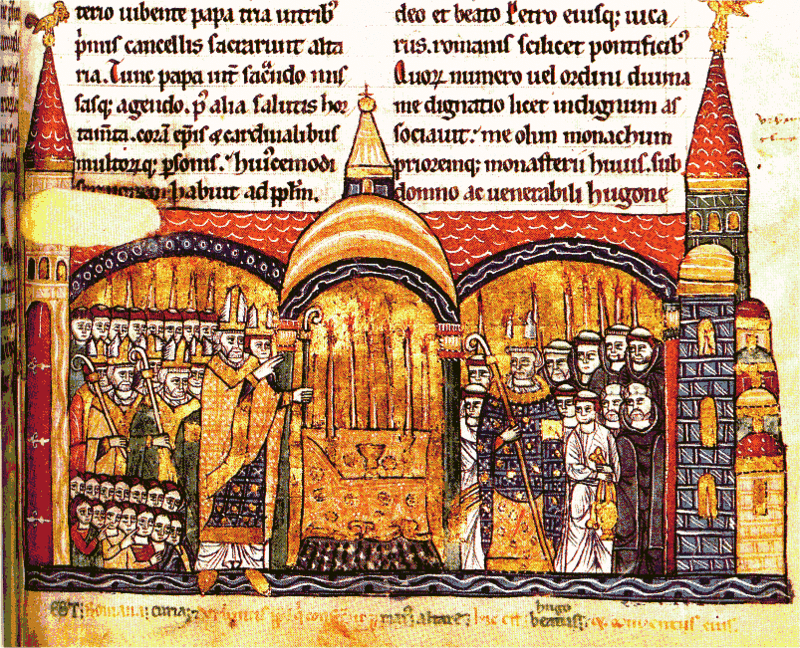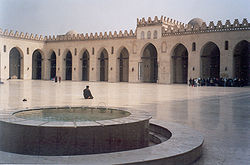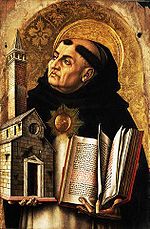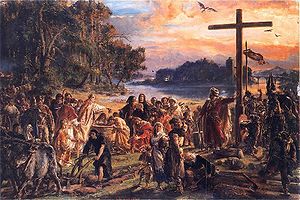
Christianity in the 10th century
Encyclopedia

Pre-scholastic Theology
With the division and decline of the Carolingian Empire, notable theological activity was preserved in some of the Cathedral schools that had begun to rise to prominence under it – for instance at AuxerreAuxerre
Auxerre is a commune in the Bourgogne region in north-central France, between Paris and Dijon. It is the capital of the Yonne department.Auxerre's population today is about 45,000...
in the 9th century or Chartres
Chartres
Chartres is a commune and capital of the Eure-et-Loir department in northern France. It is located southwest of Paris.-Geography:Chartres is built on the left bank of the Eure River, on a hill crowned by its famous cathedral, the spires of which are a landmark in the surrounding country...
in the 11th. Intellectual influences from the Arabic world (including works of classical authors preserved by Islamic scholars) percolated into the Christian West via Spain, influencing such theologians as Gerbert of Aurillac, who went on to become Pope Sylvester II and mentor to Otto III. (Otto was the fourth ruler of the Germanic Ottonian
Ottonian
The Ottonian dynasty was a dynasty of Germanic Kings , named after its first emperor but also known as the Saxon dynasty after the family's origin. The family itself is also sometimes known as the Liudolfings, after its earliest known member Liudolf and one of its primary leading-names...
Holy Roman Empire
Holy Roman Empire
The Holy Roman Empire was a realm that existed from 962 to 1806 in Central Europe.It was ruled by the Holy Roman Emperor. Its character changed during the Middle Ages and the Early Modern period, when the power of the emperor gradually weakened in favour of the princes...
, successor to the Carolingian Empire). With hindsight, one might say that a new note was struck when a controversy about the meaning of the eucharist blew up around Berengar of Tours
Berengar of Tours
Berengar of Tours was a French 11th century Christian theologian and Archdeacon of Angers, a scholar whose leadership of the cathedral school at Chartres set an example of intellectual inquiry through the revived tools of dialectic that was soon followed at cathedral schools of Laon and Paris, ...
in the 11th century: hints of a new confidence in the intellectual investigation of the faith that perhaps foreshadowed the explosion of theological argument that was to take place in the 12th century.
Notable authors include:
- Remigius of AuxerreRemigius of AuxerreRemigius of Auxerre was a Benedictine monk during the Carolingian period, a teacher of Latin grammar, and a prolific author of commentaries on classical Greek and Latin texts...
(c.841-908) - Gerbert of Aurillac (c.950-1003)
The Iberian peninsula under the Umayyads and the Berber dynasties
By the end of the 10th century, the ruler Abd al-Rahman III took over the title of Emir of CórdobaCaliphate of Córdoba
The Caliphate of Córdoba ruled the Iberian peninsula and part of North Africa, from the city of Córdoba, from 929 to 1031. This period was characterized by remarkable success in trade and culture; many of the masterpieces of Islamic Iberia were constructed in this period, including the famous...
(912-961). Soon after, the Umayyads went on developing a strengthened state with its capital as Córdoba
Córdoba, Spain
-History:The first trace of human presence in the area are remains of a Neanderthal Man, dating to c. 32,000 BC. In the 8th century BC, during the ancient Tartessos period, a pre-urban settlement existed. The population gradually learned copper and silver metallurgy...
. Al-Hakam II
Al-Hakam II
Al-Hakam II was the second Caliph of Cordoba, in Al-Andalus , and son of Abd-ar-rahman III . He ruled from 961 to 976....
succeeded to the Caliphate after the death of his father Abd ar-Rahman III in 961. He secured peace with the Christian kingdoms of northern Iberia, and made use of the stability to develop agriculture through the construction of irrigation works. Economical development was also encouraged through the widening of streets and the building of markets. The rule of the Caliphate is known as the heyday of Muslim presence in the peninsula.
The Fatimid Empire

Fatimid
The Fatimid Islamic Caliphate or al-Fāṭimiyyūn was a Berber Shia Muslim caliphate first centered in Tunisia and later in Egypt that ruled over varying areas of the Maghreb, Sudan, Sicily, the Levant, and Hijaz from 5 January 909 to 1171.The caliphate was ruled by the Fatimids, who established the...
dynasty in 909. By around 960, the Fatimids had conquered Abbasid Egypt, building a new capital there in 973 called "al-Qahirah" (meaning "the planet of victory", known today as Cairo
Cairo
Cairo , is the capital of Egypt and the largest city in the Arab world and Africa, and the 16th largest metropolitan area in the world. Nicknamed "The City of a Thousand Minarets" for its preponderance of Islamic architecture, Cairo has long been a centre of the region's political and cultural life...
). Similar was the case in Persia, where the Turkic
Turkic peoples
The Turkic peoples are peoples residing in northern, central and western Asia, southern Siberia and northwestern China and parts of eastern Europe. They speak languages belonging to the Turkic language family. They share, to varying degrees, certain cultural traits and historical backgrounds...
Ghaznavids managed to snatch power from the Abbasids.
The Fatimids had their origins in Ifriqiya
Ifriqiya
In medieval history, Ifriqiya or Ifriqiyah was the area comprising the coastal regions of what are today western Libya, Tunisia, and eastern Algeria. This area included what had been the Roman province of Africa, whose name it inherited....
(modern-day Tunisia
Tunisia
Tunisia , officially the Tunisian RepublicThe long name of Tunisia in other languages used in the country is: , is the northernmost country in Africa. It is a Maghreb country and is bordered by Algeria to the west, Libya to the southeast, and the Mediterranean Sea to the north and east. Its area...
and eastern Algeria
Algeria
Algeria , officially the People's Democratic Republic of Algeria , also formally referred to as the Democratic and Popular Republic of Algeria, is a country in the Maghreb region of Northwest Africa with Algiers as its capital.In terms of land area, it is the largest country in Africa and the Arab...
). The dynasty was founded in 909 by , who legitimised his claim through descent from Muhammad
Muhammad
Muhammad |ligature]] at U+FDF4 ;Arabic pronunciation varies regionally; the first vowel ranges from ~~; the second and the last vowel: ~~~. There are dialects which have no stress. In Egypt, it is pronounced not in religious contexts...
by way of his daughter Fātima as-Zahra
Fatimah
Fatimah was a daughter of the Islamic prophet Muhammad from his first wife Khadijah bint Khuwaylid. She is regarded by Muslims as an exemplar for men and women. She remained at her father's side through the difficulties suffered by him at the hands of the Quraysh of Mecca...
and her husband , the first Imām
Imam
An imam is an Islamic leadership position, often the worship leader of a mosque and the Muslim community. Similar to spiritual leaders, the imam is the one who leads Islamic worship services. More often, the community turns to the mosque imam if they have a religious question...
, hence the name al-Fātimiyyūn "Fatimid".
Abdullāh al-Mahdi's control soon extended over all of central Maghreb
Maghreb
The Maghreb is the region of Northwest Africa, west of Egypt. It includes five countries: Morocco, Algeria, Tunisia, Libya, and Mauritania and the disputed territory of Western Sahara...
, an area consisting of the modern countries of Morocco
Morocco
Morocco , officially the Kingdom of Morocco , is a country located in North Africa. It has a population of more than 32 million and an area of 710,850 km², and also primarily administers the disputed region of the Western Sahara...
, Algeria
Algeria
Algeria , officially the People's Democratic Republic of Algeria , also formally referred to as the Democratic and Popular Republic of Algeria, is a country in the Maghreb region of Northwest Africa with Algiers as its capital.In terms of land area, it is the largest country in Africa and the Arab...
, Tunisia
Tunisia
Tunisia , officially the Tunisian RepublicThe long name of Tunisia in other languages used in the country is: , is the northernmost country in Africa. It is a Maghreb country and is bordered by Algeria to the west, Libya to the southeast, and the Mediterranean Sea to the north and east. Its area...
and Libya
Libya
Libya is an African country in the Maghreb region of North Africa bordered by the Mediterranean Sea to the north, Egypt to the east, Sudan to the southeast, Chad and Niger to the south, and Algeria and Tunisia to the west....
, which he ruled from Mahdia
Mahdia
Mahdia is a provincial centre north of Sfax. It is important for the associated fish-processing industry, as well as weaving. It is the capital of Mahdia Governorate.- History :...
, his newly-built capital in Tunisia.
The Fatimids entered Egypt in the late 10th century, conquering the Ikhshidid dynasty
Ikhshidid dynasty
The Ikhshidid dynasty of Egypt ruled from 935 to 969. The dynasty carried the Arabic title "Wali" reflecting their position as governors on behalf of the Abbasids, the first governor was Muhammad bin Tughj Al-Ikhshid, a Turkic slave soldier, who was installed by the Abbasid Caliph and gave him and...
and founding a new capital at al-Qāhira(Cairo
Cairo
Cairo , is the capital of Egypt and the largest city in the Arab world and Africa, and the 16th largest metropolitan area in the world. Nicknamed "The City of a Thousand Minarets" for its preponderance of Islamic architecture, Cairo has long been a centre of the region's political and cultural life...
) in 969. The name was a reference to the planet Mars, "The Subduer", which was prominent in the sky at the moment that city construction started. Cairo was intended as a royal enclosure for the Fatimid caliph and his army, though the actual administrative and economic capital of Egypt was in cities such as Fustat until 1169. After Egypt, the Fatimids continued to conquer the surrounding areas until they ruled from Tunisia to Syria
Syria
Syria , officially the Syrian Arab Republic , is a country in Western Asia, bordering Lebanon and the Mediterranean Sea to the West, Turkey to the north, Iraq to the east, Jordan to the south, and Israel to the southwest....
and even crossed over into Sicily
Sicily
Sicily is a region of Italy, and is the largest island in the Mediterranean Sea. Along with the surrounding minor islands, it constitutes an autonomous region of Italy, the Regione Autonoma Siciliana Sicily has a rich and unique culture, especially with regard to the arts, music, literature,...
and southern Italy
Italy
Italy , officially the Italian Republic languages]] under the European Charter for Regional or Minority Languages. In each of these, Italy's official name is as follows:;;;;;;;;), is a unitary parliamentary republic in South-Central Europe. To the north it borders France, Switzerland, Austria and...
.
Monastic Reform Movement

Rule of St Benedict
The Rule of Saint Benedict is a book of precepts written by St. Benedict of Nursia for monks living communally under the authority of an abbot. Since about the 7th century it has also been adopted by communities of women...
, the abbey of Cluny
Cluny Abbey
Cluny Abbey is a Benedictine monastery in Cluny, Saône-et-Loire, France. It was built in the Romanesque style, with three churches built in succession from the 10th to the early 12th centuries....
became the acknowledged leader of western monasticism from the later 10th century. A sequence of highly competent abbots of Cluny were statesmen on an international level. The monastery of Cluny itself became the grandest, most prestigious and best endowed monastic institution in Europe. Cluny created a large, federated order in which the administrators of subsidiary houses served as deputies of the abbot of Cluny and answered to him. Free of lay and episcopal interference, responsible only to the papacy, the Cluniac spirit was a revitalising influence on the Norman church. The height of Cluniac influence was from the second half of the 10th century through the early 12th.
The Cluniac reform
Cluniac Reforms
The Cluniac Reforms were a series of changes within medieval monasticism of West focused on restoring the traditional monastic life, encouraging art, and caring for the poor. The movement is named for the Abbey of Cluny in Burgundy, where it started within the Benedictine order. The reforms were...
of monasteries that began in 910 placed abbots under the direct control of the pope rather than the secular control of feudal lords, thus eliminating a major source of corruption. This sparked a great monastic renewal. Monasteries, convents and cathedrals still operated virtually all schools and libraries, and often functioned as credit establishments promoting economic growth. After 1100, some older cathedral schools split into lower grammar schools and higher schools for advanced learning. First in Bologna
University of Bologna
The Alma Mater Studiorum - University of Bologna is the oldest continually operating university in the world, the word 'universitas' being first used by this institution at its foundation. The true date of its founding is uncertain, but believed by most accounts to have been 1088...
, then at Paris
University of Paris
The University of Paris was a university located in Paris, France and one of the earliest to be established in Europe. It was founded in the mid 12th century, and officially recognized as a university probably between 1160 and 1250...
and Oxford
University of Oxford
The University of Oxford is a university located in Oxford, United Kingdom. It is the second-oldest surviving university in the world and the oldest in the English-speaking world. Although its exact date of foundation is unclear, there is evidence of teaching as far back as 1096...
, many of these higher schools developed into universities
Medieval university
Medieval university is an institution of higher learning which was established during High Middle Ages period and is a corporation.The first institutions generally considered to be universities were established in Italy, France, and England in the late 11th and the 12th centuries for the study of...
and became the direct ancestors of modern Western institutions of learning. It was here where notable theologians worked to explain the connection between human experience and faith.

Thomas Aquinas
Thomas Aquinas, O.P. , also Thomas of Aquin or Aquino, was an Italian Dominican priest of the Catholic Church, and an immensely influential philosopher and theologian in the tradition of scholasticism, known as Doctor Angelicus, Doctor Communis, or Doctor Universalis...
, produced Summa Theologica
Summa Theologica
The Summa Theologiæ is the best-known work of Thomas Aquinas , and although unfinished, "one of the classics of the history of philosophy and one of the most influential works of Western literature." It is intended as a manual for beginners in theology and a compendium of all of the main...
, a key intellectual achievement in its synthesis of Aristotelian
Aristotle
Aristotle was a Greek philosopher and polymath, a student of Plato and teacher of Alexander the Great. His writings cover many subjects, including physics, metaphysics, poetry, theater, music, logic, rhetoric, linguistics, politics, government, ethics, biology, and zoology...
thought and the Gospel. Monastic contributions to western society included the teaching of metallurgy, the introduction of new crops, the invention of musical notation and the creation and preservation of literature.
Western monastic orders
- Cluniacs, a movement with a height c.950-c.1130
- Canons RegularCanons RegularCanons Regular are members of certain bodies of Canons living in community under the Augustinian Rule , and sharing their property in common...
, a community of mainly priests living according to the Rule of St. AugustineAugustine of HippoAugustine of Hippo , also known as Augustine, St. Augustine, St. Austin, St. Augoustinos, Blessed Augustine, or St. Augustine the Blessed, was Bishop of Hippo Regius . He was a Latin-speaking philosopher and theologian who lived in the Roman Africa Province... - Carthusians
- CelestinesCelestinesCelestines are a Roman Catholic monastic order, a branch of the Benedictines, founded in 1244. At the foundation of the new rule, they were called Hermits of St Damiano, or Moronites , and did not assume the appellation of Celestines until after the election of their founder to the Papacy as...
- Conventuals
- Discalced CarmelitesDiscalced CarmelitesThe Discalced Carmelites, or Barefoot Carmelites, is a Catholic mendicant order with roots in the eremitic tradition of the Desert Fathers and Mothers...
- OlivetansOlivetansThe Olivetans, or the Order of Our Lady of Mount Olivet, are a monastic order formally recognised in 1344. They have formed the Olivetan Congregation within the Benedictine Confederation since 1960.-History:...
- Premonstratensians, also known as Norbertines.
- Servites
- Vallombrosans
- Visitation Sisters
Poland

The "Baptism of Poland" in 966 refers to the baptism of Mieszko I
Mieszko I of Poland
Mieszko I , was a Duke of the Polans from about 960 until his death. A member of the Piast dynasty, he was son of Siemomysł; grandchild of Lestek; father of Bolesław I the Brave, the first crowned King of Poland; likely father of Świętosława , a Nordic Queen; and grandfather of her son, Cnut the...
, the first ruler of a united Polish state. His baptism was followed by the building of churches and the establishment of an ecclesiastical hierarchy. Mieszko saw baptism as a way of strengthening his hold on power, with the active support he could expect from the bishops, as well as a unifying force for the Polish people. Mieszko's action proved highly successful; by the 13th century, Roman Catholicism had become the dominant religion
Religion
Religion is a collection of cultural systems, belief systems, and worldviews that establishes symbols that relate humanity to spirituality and, sometimes, to moral values. Many religions have narratives, symbols, traditions and sacred histories that are intended to give meaning to life or to...
in Poland.
Hungary
In the Middle Ages, the Kingdom of HungaryKingdom of Hungary in the Middle Ages
The Kingdom of Hungary was formed from the previous Principality of Hungarywith the coronation of Stephen I in AD 1000. This was a result of the conversion of Géza of Hungary to the Western Church in the 970s....
(which was larger than modern day Hungary
Hungary
Hungary , officially the Republic of Hungary , is a landlocked country in Central Europe. It is situated in the Carpathian Basin and is bordered by Slovakia to the north, Ukraine and Romania to the east, Serbia and Croatia to the south, Slovenia to the southwest and Austria to the west. The...
) was Christianized between 970 and 1038.
Kievan Rus'
The traditional event associated with the conversion of Russia is the baptism of Vladimir of Kiev in 989, on which occasion he was also married to the Byzantine princess Anna, the sister of the Byzantine Emperor Basil IIBasil II
Basil II , known in his time as Basil the Porphyrogenitus and Basil the Young to distinguish him from his ancestor Basil I the Macedonian, was a Byzantine emperor from the Macedonian dynasty who reigned from 10 January 976 to 15 December 1025.The first part of his long reign was dominated...
. However, Christianity is documented to have predated this event in the city of Kiev and in Georgia.
The success of the conversion of the Bulgarians facilitated the conversion of other East Slavic peoples
Slavic peoples
The Slavic people are an Indo-European panethnicity living in Eastern Europe, Southeast Europe, North Asia and Central Asia. The term Slavic represents a broad ethno-linguistic group of people, who speak languages belonging to the Slavic language family and share, to varying degrees, certain...
, most notably the Rus'
Rus' (people)
The Rus' were a group of Varangians . According to the Primary Chronicle of Rus, compiled in about 1113 AD, the Rus had relocated from the Baltic region , first to Northeastern Europe, creating an early polity which finally came under the leadership of Rurik...
, predecessors of Belarusians
Belarusians
Belarusians ; are an East Slavic ethnic group who populate the majority of the Republic of Belarus. Introduced to the world as a new state in the early 1990s, the Republic of Belarus brought with it the notion of a re-emerging Belarusian ethnicity, drawn upon the lines of the Old Belarusian...
, Russians
Russians
The Russian people are an East Slavic ethnic group native to Russia, speaking the Russian language and primarily living in Russia and neighboring countries....
, and Ukrainians
Ukrainians
Ukrainians are an East Slavic ethnic group native to Ukraine, which is the sixth-largest nation in Europe. The Constitution of Ukraine applies the term 'Ukrainians' to all its citizens...
. By the beginning of the 11th century most of the Slavic world, including, Bulgaria, Serbia, and Russia had converted to Eastern Orthodox Christianity.
Bulgaria's Church was officially recognized as a Patriarchate by Constantinople in 927, Serbia's in 1346, and Russia's in 1589. All these nations, however, had been converted long before these dates.
The traditional event associated with the conversion of Russia is the baptism of Vladimir of Kiev in 989, on which occasion he was also married to the Byzantine princess Anna, the sister of the Byzantine Emperor Basil II
Basil II
Basil II , known in his time as Basil the Porphyrogenitus and Basil the Young to distinguish him from his ancestor Basil I the Macedonian, was a Byzantine emperor from the Macedonian dynasty who reigned from 10 January 976 to 15 December 1025.The first part of his long reign was dominated...
. However, the presence of Christianity in these areas is documented to have predated this event.
Between the 8th and the 13th century the area of what now is Belarus
Belarus
Belarus , officially the Republic of Belarus, is a landlocked country in Eastern Europe, bordered clockwise by Russia to the northeast, Ukraine to the south, Poland to the west, and Lithuania and Latvia to the northwest. Its capital is Minsk; other major cities include Brest, Grodno , Gomel ,...
, Russia
Russia
Russia or , officially known as both Russia and the Russian Federation , is a country in northern Eurasia. It is a federal semi-presidential republic, comprising 83 federal subjects...
and the Ukraine
Ukraine
Ukraine is a country in Eastern Europe. It has an area of 603,628 km², making it the second largest contiguous country on the European continent, after Russia...
was settled by the Kievan Rus'
Kievan Rus'
Kievan Rus was a medieval polity in Eastern Europe, from the late 9th to the mid 13th century, when it disintegrated under the pressure of the Mongol invasion of 1237–1240....
. An attempt to Christianize them had already been made in the 9th century, with the Christianization of the Rus' Khaganate
Christianization of the Rus' Khaganate
The Christianization of the Rus' Khaganate is supposed to have happened in the 860s and was the first stage in the process of Christianization of the East Slavs which continued well into the 11th century...
. The efforts were finally successful in the 10th century, when about 980 Vladimir the Great was baptized at Chersonesos.
by AD 1100, Germanic paganism
Germanic paganism
Germanic paganism refers to the theology and religious practices of the Germanic peoples of north-western Europe from the Iron Age until their Christianization during the Medieval period...
had also ceased to have political influence in Scandinavia
Scandinavia
Scandinavia is a cultural, historical and ethno-linguistic region in northern Europe that includes the three kingdoms of Denmark, Norway and Sweden, characterized by their common ethno-cultural heritage and language. Modern Norway and Sweden proper are situated on the Scandinavian Peninsula,...
.
Further reading
- Lawrence, C. H. Medieval Monasticism. 3rd ed. Harlow: Pearson Education, 2001. ISBN 0-582-40427-4
- Fletcher, Richard, The Conversion of Europe. From Paganism to Christianity 371-1386 AD. London 1997.
- Padberg, Lutz v., (1998): Die Christianisierung Europas im Mittelalter, Stuttgart, Reclam (German)
External links
See also
- History of ChristianityHistory of ChristianityThe history of Christianity concerns the Christian religion, its followers and the Church with its various denominations, from the first century to the present. Christianity was founded in the 1st century by the followers of Jesus of Nazareth who they believed to be the Christ or chosen one of God...
- History of the Roman Catholic ChurchHistory of the Roman Catholic ChurchAs the oldest branch of Christianity, along with Eastern Orthodoxy, the history of the Catholic Church plays an integral part of the History of Christianity as a whole. This article covers a period of just under 2,000 years....
- History of the Eastern Orthodox ChurchHistory of the Eastern Orthodox ChurchThe Eastern Orthodox Churches trace their roots back to the Apostles and Jesus Christ. Apostolic succession established the seats of Patriarchy...
- History of Christian theologyHistory of Christian theologyThe doctrine of the Trinity, considered the core of Christian theology by Trinitarians, is the result of continuous exploration by the church of the biblical data, thrashed out in debate and treatises, eventually formulated at the First Council of Nicaea in 325 AD in a way they believe is...
- History of Oriental OrthodoxyHistory of Oriental OrthodoxyOriental Orthodoxy is the communion of Eastern Christian Churches that recognize only three ecumenical councils — the First Council of Nicaea, the First Council of Constantinople and the Council of Ephesus. They reject the dogmatic definitions of the Council of Chalcedon...
- ChristianizationChristianizationThe historical phenomenon of Christianization is the conversion of individuals to Christianity or the conversion of entire peoples at once...
- Timeline of Christianity#Middle Ages
- Timeline of Christian missions#Middle Ages
- Timeline of the Roman Catholic Church#800–1453
- Chronological list of saints in the 10th century
- 10th century
- Timeline of 10th century Muslim historyTimeline of 10th century Muslim history-10th century :* 902: Death of the Abbasid Caliph al-Mu'tadid; al-Muktafi becomes Caliph. Death of the Saffarid ruler Amr bin Laith.* 903: Assassination of the Qarmatian ruler Abu Said of Qarmatian; accession of Abu Tahir....
| History of Christianity History of Christianity The history of Christianity concerns the Christian religion, its followers and the Church with its various denominations, from the first century to the present. Christianity was founded in the 1st century by the followers of Jesus of Nazareth who they believed to be the Christ or chosen one of God... : The Middle Ages History of medieval Christianity The history of medieval Christianity traces Christianity during the Middle Ages - the period after the Fall of Rome until the Protestant Reformation , considered the start of the modern era.... |
||||||||||
| Preceded by: Christianity in the 9th century Christianity in the 9th century The High Middle Ages begins in the 9th century with the coronation of Charlemagne in 800 and continued with the Photian schism.- Carolingian Renaissance :... |
10th Century 10th century The 10th century is the period from 901 to 1000 in accordance with the Julian calendar in the Christian/Common Era.The 10th century is usually regarded as a low point in European history. In China it was also a period of political upheaval. In the Muslim World, however, it was a cultural zenith,... |
Followed by: Christianity in the 11th century Christianity in the 11th century In 1054, following the death of the Patriarch of Rome Leo IX, papal legates from Rome traveled to Constantinople to deny Michael Cerularius, the reigning Patriarch of Constantinople, the title of Ecumenical Patriarch and to insist that he recognize the Church of Rome's claim to be the head and... |
||||||||

